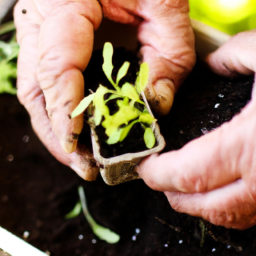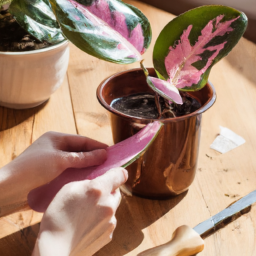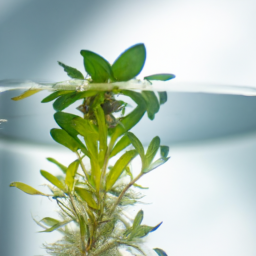
Have you ever tried propagating plants in water? Plant propagation in water is a simple and effective method for growing new plants from cuttings. Whether you’re a seasoned gardener or a beginner looking to expand your indoor plant collection, water propagation is a fun and rewarding way to increase your green thumb skills. In this blog post, we’ll explore the benefits of propagating plants in water, the best plants to propagate in water, and step-by-step instructions for successfully propagating your own plants at home. So grab your favorite glass jar, some fresh cuttings, and let’s get started on this exciting plant propagation journey!
Benefits of Plant Propagation in Water
Introduction
When it comes to propagating plants, there are several methods to choose from. One popular and effective method is propagating plants in water. This method involves placing plant cuttings in water until roots develop, allowing the plant to grow into a healthy and vibrant new plant. There are several benefits to propagating plants in water, which we will explore in this article.
Healthier Root Development
One of the main benefits of propagating plants in water is that it allows for healthier root development. When a plant cutting is placed in water, it is able to easily absorb the nutrients it needs to grow roots. This leads to stronger and more robust root systems, which are essential for the overall health and growth of the plant. Additionally, propagating plants in water allows you to monitor the root development more easily, ensuring that the roots are growing properly and are not becoming root-bound.
Another benefit of propagating plants in water is that it can help to speed up the rooting process. When a plant cutting is placed in water, it is able to quickly establish roots, allowing the plant to grow more quickly and effectively. This can be especially beneficial if you are propagating plants for a specific purpose, such as creating new plants for your garden or sharing with friends and family.
Cost-effective and Sustainable
Propagating plants in water is also a cost-effective and sustainable method of plant propagation. Instead of purchasing new plants or seeds, you can simply take cuttings from existing plants and propagate them in water. This not only saves you money, but it also helps to reduce waste and promote sustainability in your gardening practices.
Additionally, propagating plants in water can help to preserve rare or hard-to-find plant varieties. By propagating plants in water, you can easily create new plants from cuttings of existing plants, ensuring that rare or unique plant varieties are not lost. This can be especially important for plant enthusiasts who are passionate about preserving and sharing rare plant species.
In conclusion, propagating plants in water offers several benefits, including healthier root development, faster rooting processes, cost-effectiveness, and sustainability. Whether you are a seasoned gardener or just starting out, propagating plants in water is a simple and effective method that can help you grow healthy and vibrant plants. So why not give it a try and see the benefits for yourself?
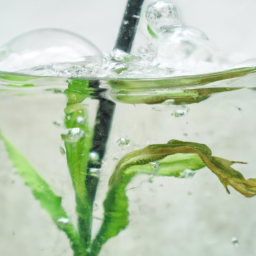
Best Plants for Water Propagation
Introduction
When it comes to propagating plants in water, not all plants are created equal. Some plants thrive in water propagation, while others may struggle to root or even die. In this guide, we will explore the best plants for water propagation and provide you with step-by-step instructions on how to propagate them successfully.
Pothos
Pothos, also known as Devil’s Ivy, is one of the easiest plants to propagate in water. Simply take a cutting from a healthy pothos plant, making sure it has at least two nodes. Nodes are the small bumps on the stem where roots will grow. Place the cutting in a jar of water, making sure the nodes are submerged. Keep the jar in a bright, indirect light location and change the water every few days to prevent rot. In a few weeks, you should start to see roots forming. Once the roots are a few inches long, you can transplant the cutting into soil.
Pothos is a great plant for beginners because it is very forgiving and can thrive in a variety of conditions. It is also a fast grower, so you will see results relatively quickly. Once your pothos cutting has rooted in water, you can enjoy watching it grow into a beautiful, trailing plant.
Another benefit of propagating pothos in water is that you can easily monitor the root development. This can help you determine when it is time to transplant the cutting into soil. Remember to keep the soil moist but not waterlogged, and your pothos plant will continue to thrive.
Spider Plant
Spider plants are another popular choice for water propagation. To propagate a spider plant in water, simply take a healthy baby spider plant, known as a spiderette, and place it in a jar of water. Make sure the roots are submerged and change the water regularly to prevent mold and rot. Spider plants are very adaptable and can tolerate a wide range of light conditions, making them an excellent choice for beginners.
One thing to keep in mind when propagating spider plants in water is that they can be sensitive to fluoride in tap water. If you notice browning tips on the leaves, try using filtered or distilled water instead. Spider plants are also sensitive to overwatering, so be sure to change the water regularly and avoid letting the roots sit in water for too long.
Once the roots are a few inches long, you can transplant the spiderette into soil. Spider plants are known for their air-purifying qualities, making them a great addition to any indoor space. With proper care and attention, your spider plant will continue to thrive and produce new spiderettes for you to propagate in water.
Monstera
Monstera plants, with their iconic Swiss cheese leaves, are a popular choice for water propagation. To propagate a Monstera plant in water, take a stem cutting with at least one node and place it in a jar of water. Make sure the node is submerged and change the water regularly to prevent rot. Monstera plants prefer bright, indirect light and high humidity, so be sure to place the jar in a location that meets these requirements.
One of the benefits of propagating Monstera plants in water is that you can easily monitor root development. Once the roots are a few inches long, you can transplant the cutting into soil. Monstera plants are relatively low-maintenance and can thrive in a variety of conditions, making them a great choice for beginners.
When caring for a Monstera plant propagated in water, be sure to provide it with a well-draining soil mix and water it regularly. Monstera plants are known for their fast growth and unique foliage, making them a popular choice for indoor plant enthusiasts. With the right care and attention, your Monstera plant will continue to grow and thrive in its new home.
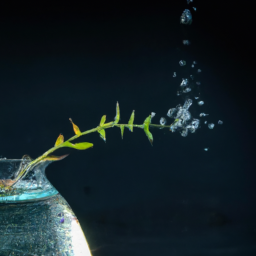
Steps for Successful Plant Propagation in Water
Choosing the Right Plants
When it comes to propagating plants in water, not all plants are created equal. Some plants are more suitable for water propagation than others. It’s important to choose plants that are known to root well in water, such as pothos, spider plants, and philodendrons. These plants have the ability to grow roots quickly and easily in water, making them ideal candidates for water propagation.
Before you start the propagation process, make sure to select healthy plant cuttings. Look for cuttings that have at least one leaf node, as this is where the roots will emerge from. It’s also important to choose cuttings that are free from any signs of disease or damage. Healthy cuttings will have a better chance of successfully rooting in water.
Once you have selected your plant cuttings, it’s time to prepare them for propagation. Trim the cutting just below a leaf node, and remove any excess leaves from the lower portion of the cutting. This will help the cutting focus its energy on root growth, rather than supporting unnecessary foliage.
Next, place the cutting in a container filled with room temperature water. Make sure that at least one leaf node is submerged in the water, as this is where the roots will begin to grow. Place the container in a location with bright, indirect light, and change the water every few days to prevent the growth of algae and bacteria.
Root Development
Once you have placed your plant cuttings in water, it’s time to sit back and wait for roots to develop. Root development can take anywhere from a few days to a few weeks, depending on the type of plant and environmental conditions. During this time, it’s important to monitor the water level and quality to ensure that the cuttings have everything they need to grow roots successfully.
As the roots begin to grow, you may notice small white bumps emerging from the leaf nodes. These bumps will eventually develop into a network of roots that will support the plant as it grows. It’s important to be patient during this process, as root development can take time. Avoid moving or disturbing the cuttings, as this can disrupt the root growth process.
Once the roots have reached a sufficient length, you can transfer the cuttings to a pot filled with potting soil. Gently remove the cuttings from the water, being careful not to damage the delicate roots. Plant the cuttings in the soil, making sure to cover the roots completely. Water the newly planted cuttings thoroughly, and place them in a location with bright, indirect light to help them establish themselves in their new environment.
Maintenance and Care
After transferring your plant cuttings to soil, it’s important to provide them with the proper care to ensure their continued growth and development. Water the newly planted cuttings regularly, making sure to keep the soil moist but not waterlogged. Avoid overwatering, as this can lead to root rot and other issues.
In addition to watering, it’s important to provide your newly propagated plants with the right amount of light and humidity. Place the plants in a location with bright, indirect light, and mist them regularly to increase humidity levels. This will help the plants adjust to their new environment and promote healthy growth.
As your plants continue to grow, you may need to repot them into larger containers to accommodate their increasing size. Monitor the growth of your plants regularly, and repot them as needed to ensure that they have enough room to thrive. With proper care and attention, your propagated plants will continue to grow and flourish, adding beauty and greenery to your home.
Let’s wrap up what we learned
Plant propagation in water is a simple and effective method to grow new plants from cuttings. By placing plant cuttings in a container of water, you can encourage root growth and eventually transplant the cutting into soil once roots have developed. This technique is commonly used for indoor plants, herbs, and some vegetables.
To propagate plants in water, start by taking a cutting from a healthy, mature plant. Remove any leaves from the bottom of the cutting and place it in a container filled with water. Change the water regularly to prevent bacteria growth and monitor the cutting for root development. Once roots have formed, you can transfer the cutting to soil and continue to care for it as you would a normal plant. Plant propagation in water is a great way to expand your plant collection and experiment with different species without the need for seeds or expensive equipment. Give it a try and watch your garden grow!
Common Questions and Answers:
Q1: What is plant propagation in water?
Plant propagation in water is a method of growing new plants from cuttings or plant parts placed in water instead of soil. This technique allows the plants to develop roots before being transferred to soil.
Q2: Which plants can be propagated in water?
Many plants can be propagated in water, including pothos, philodendron, spider plants, and many herbs like mint, basil, and sage. It’s best to research the specific plant you want to propagate to ensure success.
Q3: How do I propagate plants in water?
To propagate plants in water, simply take a cutting from a healthy plant, remove lower leaves, and place the cutting in a container of water. Change the water regularly to prevent rot and wait for roots to develop before transplanting to soil.
Q4: How long does it take for roots to grow when propagating plants in water?
The time it takes for roots to grow when propagating plants in water can vary depending on the plant species, environmental conditions, and the health of the cutting. Generally, roots can start to develop within a few weeks to a month.
Q5: Can all plants be propagated in water?
Not all plants can be successfully propagated in water. Some plants, like succulents and cacti, are better suited for propagation in soil due to their unique root structures. It’s important to research the specific plant you want to propagate to determine the best method.
Dr. Olivia Green is a botanist with over two decades of experience in indoor plant cultivation. She holds a Ph.D. in Plant Biology and has dedicated her career to researching plant behavior in controlled environments. Dr. Green is passionate about helping plant enthusiasts master the art of indoor gardening through her extensive knowledge and practical insights.

